lock BMW M3 CONVERTIBLE 2002 E46 Owner's Manual
[x] Cancel search | Manufacturer: BMW, Model Year: 2002, Model line: M3 CONVERTIBLE, Model: BMW M3 CONVERTIBLE 2002 E46Pages: 159, PDF Size: 2.19 MB
Page 4 of 159
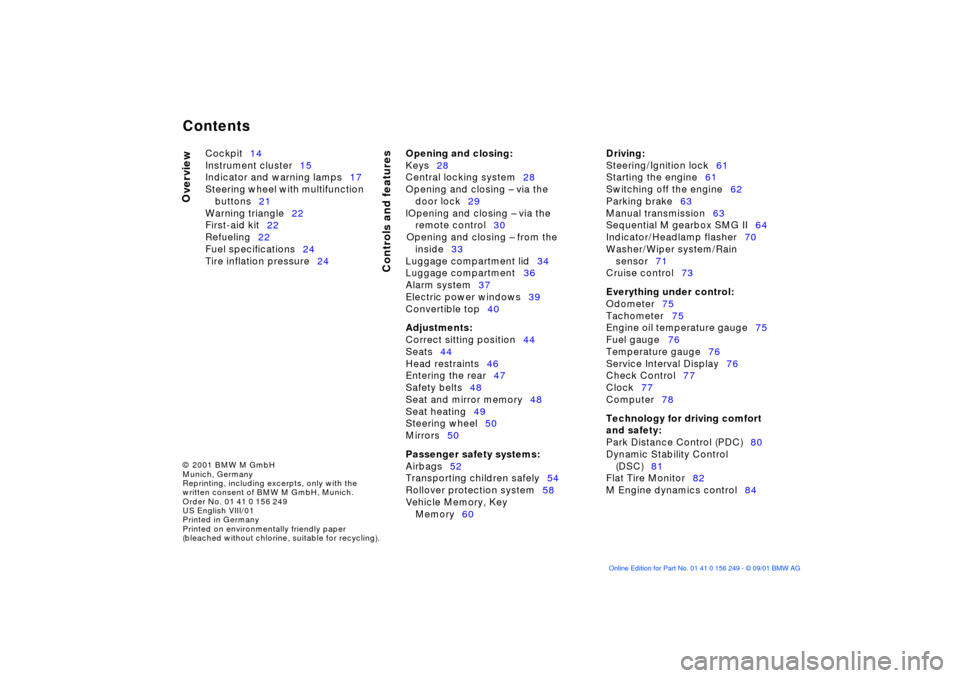
Contents
© 2001 BMW M GmbH
Munich, Germany
Reprinting, including excerpts, only with the
written consent of BMW M GmbH, Munich.
Order No. 01 41 0 156 249
US English VIII/01
Printed in Germany
Printed on environmentally friendly paper
(bleached without chlorine, suitable for recycling).
Overview
Controls and features
Cockpit14
Instrument cluster15
Indicator and warning lamps17
Steering wheel with multifunction
buttons21
Warning triangle22
First-aid kit22
Refueling22
Fuel specifications24
Tire inflation pressure24
Opening and closing:
Keys28
Central locking system28
Opening and closing Ð via the
door lock29
lOpening and closing Ð via the
remote control30
Opening and closing Ð from the
inside33
Luggage compartment lid34
Luggage compartment36
Alarm system37
Electric power windows39
Convertible top40
Adjustments:
Correct sitting position44
Seats44
Head restraints46
Entering the rear47
Safety belts48
Seat and mirror memory48
Seat heating49
Steering wheel50
Mirrors50
Passenger safety systems:
Airbags52
Transporting children safely54
Rollover protection system58
Vehicle Memory, Key
Memory60
Driving:
Steering/Ignition lock61
Starting the engine61
Switching off the engine62
Parking brake63
Manual transmission63
Sequential M gearbox SMG II64
Indicator/Headlamp flasher70
Washer/Wiper system/Rain
sensor71
Cruise control73
Everything under control:
Odometer75
Tachometer75
Engine oil temperature gauge75
Fuel gauge76
Temperature gauge76
Service Interval Display76
Check Control77
Clock77
Computer78
Technology for driving comfort
and safety:
Park Distance Control (PDC)80
Dynamic Stability Control
(DSC)81
Flat Tire Monitor82
M Engine dynamics control84
Contents
Page 5 of 159
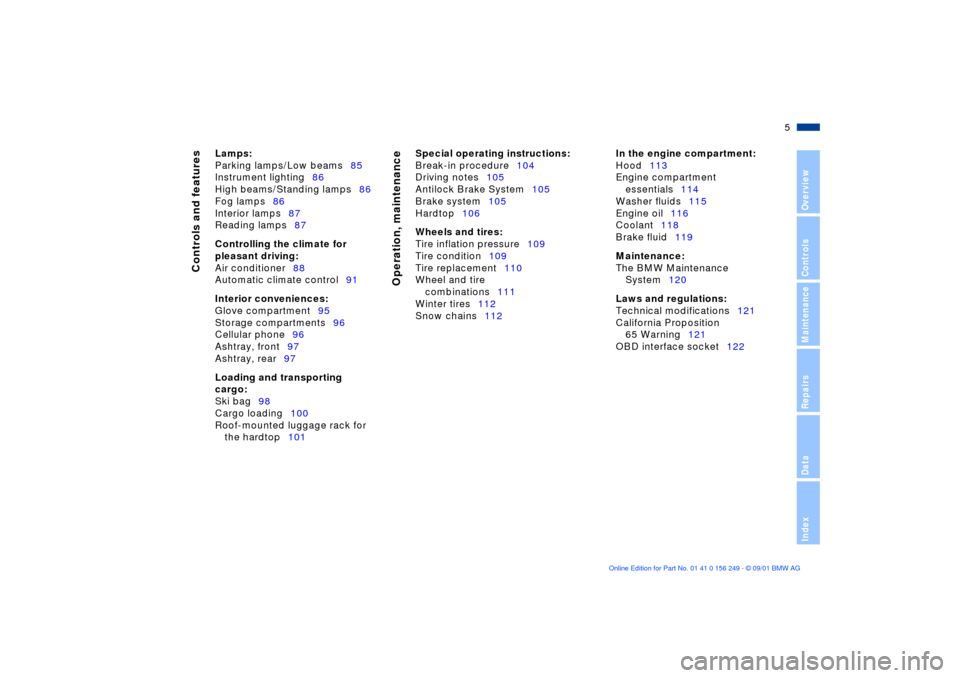
5n
OverviewControlsMaintenanceRepairsDataIndex
Controls and features
Operation, maintenance
Lamps:
Parking lamps/Low beams85
Instrument lighting86
High beams/Standing lamps86
Fog lamps86
Interior lamps87
Reading lamps87
Controlling the climate for
pleasant driving:
Air conditioner88
Automatic climate control91
Interior conveniences:
Glove compartment95
Storage compartments96
Cellular phone96
Ashtray, front97
Ashtray, rear97
Loading and transporting
cargo:
Ski bag98
Cargo loading100
Roof-mounted luggage rack for
the hardtop101
Special operating instructions:
Break-in procedure104
Driving notes105
Antilock Brake System105
Brake system105
Hardtop106
Wheels and tires:
Tire inflation pressure109
Tire condition109
Tire replacement110
Wheel and tire
combinations111
Winter tires112
Snow chains112
In the engine compartment:
Hood113
Engine compartment
essentials114
Washer fluids115
Engine oil116
Coolant118
Brake fluid119
Maintenance:
The BMW Maintenance
System120
Laws and regulations:
Technical modifications121
California Proposition
65 Warning121
OBD interface socket122
Page 14 of 159
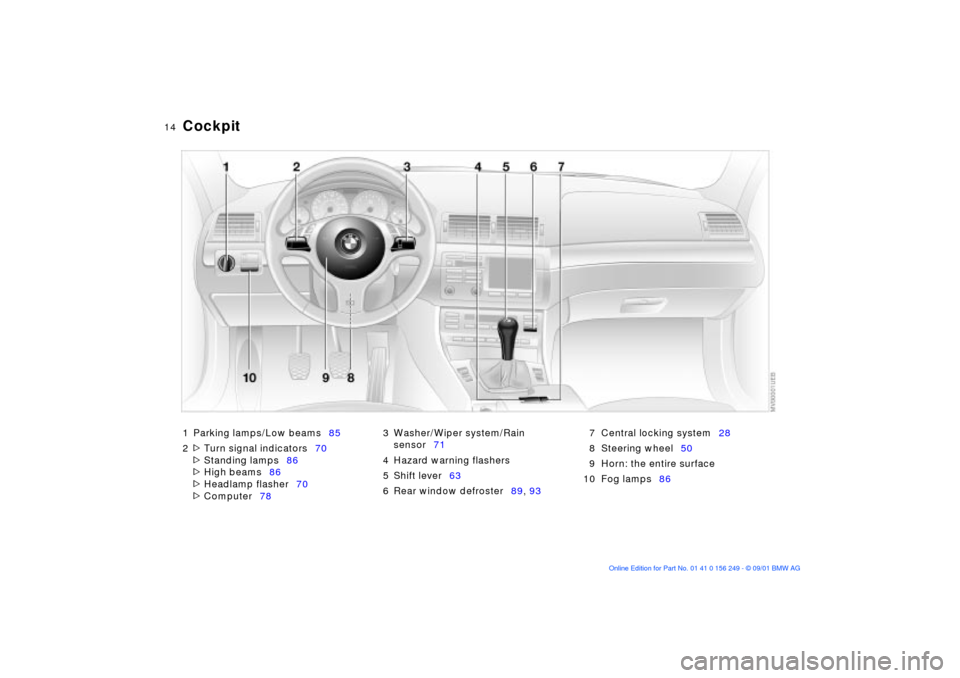
14n
1 Parking lamps/Low beams85
2
>
Turn signal indicators70
>
Standing lamps86
>
High beams86
>
Headlamp flasher70
>
Computer783 Washer/Wiper system/Rain
sensor71
4 Hazard warning flashers
5 Shift lever63
6 Rear window defroster89, 937 Central locking system28
8 Steering wheel50
9 Horn: the entire surface
10 Fog lamps86
Cockpit
Page 15 of 159

15n
OverviewControlsMaintenanceRepairsDataIndex
Instrument cluster
1 Fuel gauge76
2 Turn signal indicator20
3 Speedometer
4 Indicator and warning
lamps17 to 205 Tachometer and
Engine oil temperature75
6 Engine coolant temperature
gauge76
7 Indicator and warning
lamps17 to 208 Clock reset
>
Clock77
>
Unit of measure of outside temper-
ature display78
9 Display for sequential M gearbox
*
SMG II66
Page 16 of 159

16n
Instrument cluster
10 Indicator lamp for Dynamic Stability
Control (DSC)19
11 Display for
>
Odometer75
>
Trip odometer75
>
Clock77
>
Service Interval76Display for computer, operation
using the turn signal lever, refer to
page 78:
>
Clock
>
Outside temperature
>
Average fuel consumption
>
Range
>
Average speed12 Display for Check Control77
13 Trip odometer, reset to zero75
14 Indicator and warning
lamps17 to 20
Page 18 of 159
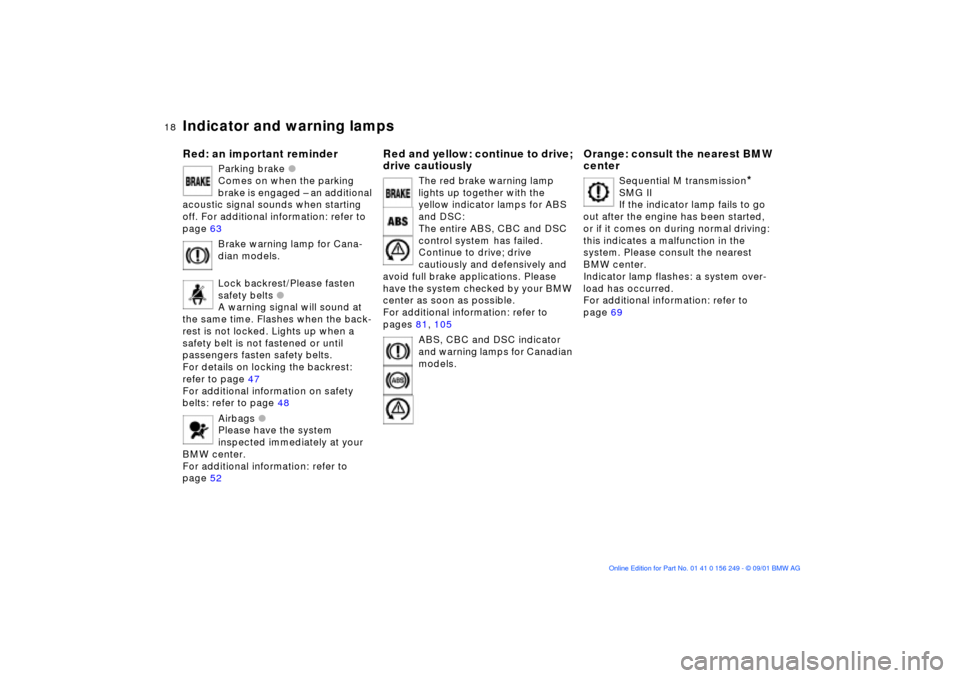
18n
Indicator and warning lamps
Red: an important reminder
Parking brake
l
Comes on when the parking
brake is engaged Ð an additional
acoustic signal sounds when starting
off. For additional information: refer to
page 63
Brake warning lamp for Cana-
dian models.
Lock backrest/Please fasten
safety belts
l
A warning signal will sound at
the same time. Flashes when the back-
rest is not locked. Lights up when a
safety belt is not fastened or until
passengers fasten safety belts.
For details on locking the backrest:
refer to page 47
For additional information on safety
belts: refer to page 48
Airbags
l
Please have the system
inspected immediately at your
BMW center.
For additional information: refer to
page 52
Red and yellow: continue to drive;
drive cautiously
The red brake warning lamp
lights up together with the
yellow indicator lamps for ABS
and DSC:
The entire ABS, CBC and DSC
control system
has failed.
Continue to drive; drive
cautiously and defensively and
avoid full brake applications. Please
have the system checked by your BMW
center as soon as possible.
For additional information: refer to
pages 81, 105
ABS, CBC and DSC indicator
and warning lamps for Canadian
models.
Orange: consult the nearest BMW
center
Sequential M transmission
*
SMG II
If the indicator lamp fails to go
out after the engine has been started,
or if it comes on during normal driving:
this indicates a malfunction in the
system. Please consult the nearest
BMW center.
Indicator lamp flashes: a system over-
load has occurred.
For additional information: refer to
page 69
Page 19 of 159
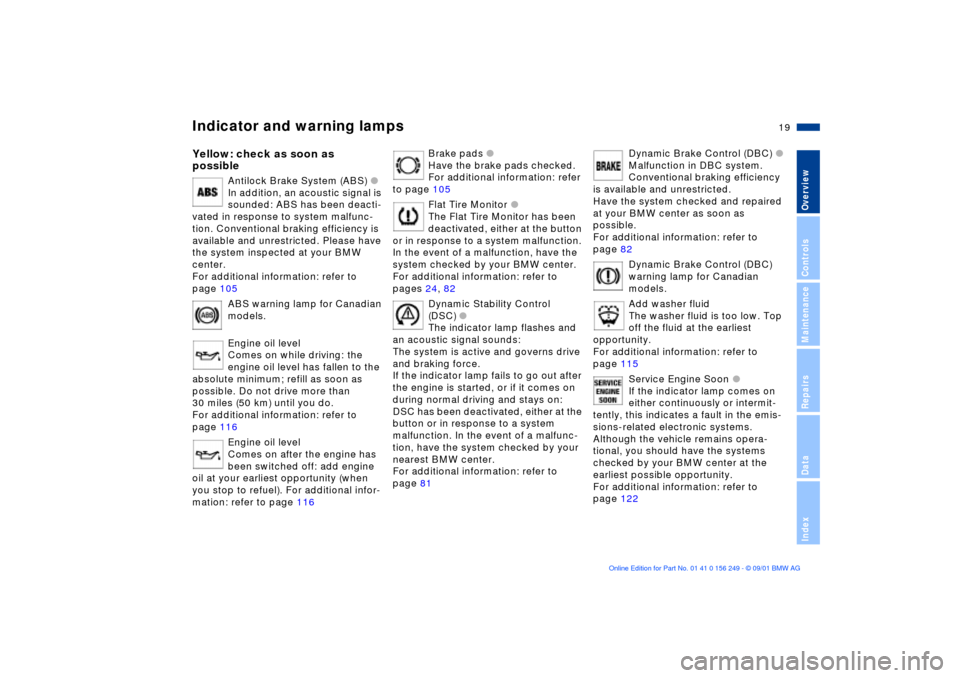
19n
OverviewControlsMaintenanceRepairsDataIndex
Indicator and warning lamps
Yellow: check as soon as
possible
Antilock Brake System (ABS)
l
In addition, an acoustic signal is
sounded: ABS has been deacti-
vated in response to system malfunc-
tion. Conventional braking efficiency is
available and unrestricted. Please have
the system inspected at your BMW
center.
For additional information: refer to
page 105
ABS warning lamp for Canadian
models.
Engine oil level
Comes on while driving: the
engine oil level has fallen to the
absolute minimum; refill as soon as
possible. Do not drive more than
30 miles (50 km) until you do.
For additional information: refer to
page 116
Engine oil level
Comes on after the engine has
been switched off: add engine
oil at your earliest opportunity (when
you stop to refuel). For additional infor-
mation: refer to page 116
Brake pads
l
Have the brake pads checked.
For additional information: refer
to page 105
Flat Tire Monitor
l
The Flat Tire Monitor has been
deactivated, either at the button
or in response to a system malfunction.
In the event of a malfunction, have the
system checked by your BMW center.
For additional information: refer to
pages 24, 82
Dynamic Stability Control
(DSC)
l
The indicator lamp flashes and
an acoustic signal sounds:
The system is active and governs drive
and braking force.
If the indicator lamp fails to go out after
the engine is started, or if it comes on
during normal driving and stays on:
DSC has been deactivated, either at the
button or in response to a system
malfunction. In the event of a malfunc-
tion, have the system checked by your
nearest BMW center.
For additional information: refer to
page 81
Dynamic Brake Control (DBC)
l
Malfunction in DBC system.
Conventional braking efficiency
is available and unrestricted.
Have the system checked and repaired
at your BMW center as soon as
possible.
For additional information: refer to
page 82
Dynamic Brake Control (DBC)
warning lamp for Canadian
models.
Add washer fluid
The washer fluid is too low. Top
off the fluid at the earliest
opportunity.
For additional information: refer to
page 115
Service Engine Soon
l
If the indicator lamp comes on
either continuously or intermit-
tently, this indicates a fault in the emis-
sions-related electronic systems.
Although the vehicle remains opera-
tional, you should have the systems
checked by your BMW center at the
earliest possible opportunity.
For additional information: refer to
page 122
Page 22 of 159
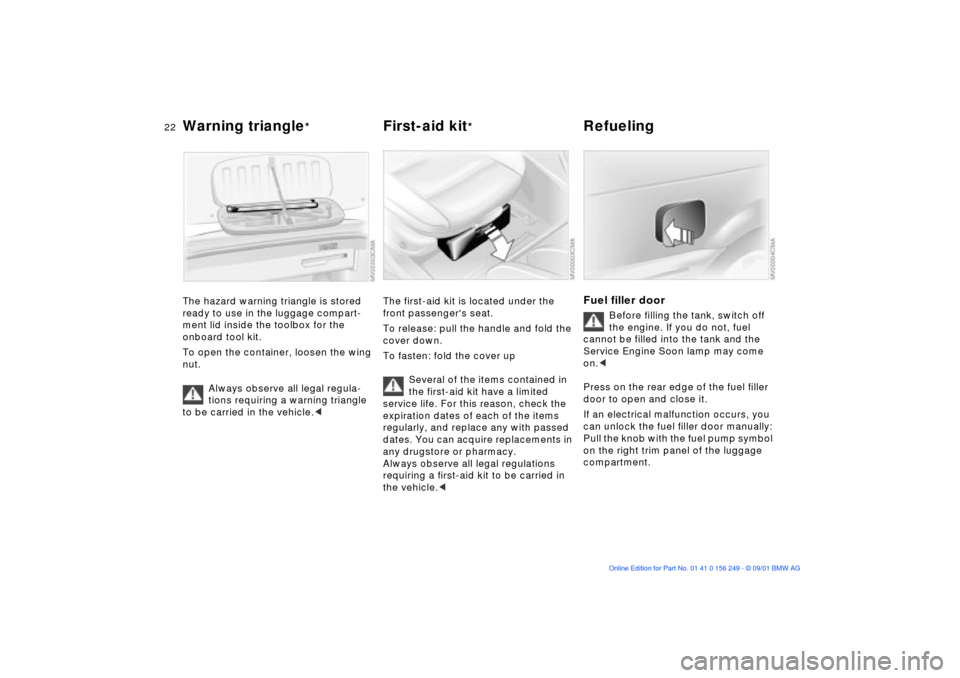
22n
Warning triangle
*
First-aid kit
*
Refueling
The hazard warning triangle is stored
ready to use in the luggage compart-
ment lid inside the toolbox for the
onboard tool kit.
To open the container, loosen the wing
nut.
Always observe all legal regula-
tions requiring a warning triangle
to be carried in the vehicle.<
The first-aid kit is located under the
front passenger's seat.
To release: pull the handle and fold the
cover down.
To fasten: fold the cover up
Several of the items contained in
the first-aid kit have a limited
service life. For this reason, check the
expiration dates of each of the items
regularly, and replace any with passed
dates. You can acquire replacements in
any drugstore or pharmacy.
Always observe all legal regulations
requiring a first-aid kit to be carried in
the vehicle.<
Fuel filler door
Before filling the tank, switch off
the engine. If you do not, fuel
cannot be filled into the tank and the
Service Engine Soon lamp may come
on.<
Press on the rear edge of the fuel filler
door to open and close it.
If an electrical malfunction occurs, you
can unlock the fuel filler door manually:
Pull the knob with the fuel pump symbol
on the right trim panel of the luggage
compartment.
Page 28 of 159

28n
Keys Central locking systemThe key set1 Master key with remote control
This key determines the functions of
the Key Memory, refer to page 60.
You can mark individual keys for
subsequent identification by applying
the colored decals that you received
when accepting delivery of your
vehicle
There is an extended-life battery
in every master key with remote
control that is charged automatically in
the ignition lock as you drive. For this
reason, if you have a master key with
remote control that is otherwise not
used, use that key at least once every
year while driving for an extended
period to charge the battery. Also refer
to page 30.<
2 Spare master key for storage in a
safe place, such as in your wallet.
This key is not intended for contin-
uous use
3 Door and ignition key
The locks for the luggage compart-
ment lid and the glove compartment
cannot be operated with this key Ð
this is recommended for valet
parking, for instance
The conceptThe central locking system engages
and releases the locks on the
>doors
>luggage compartment lid
>fuel filler door and
>glove compartment.
The central locking system is ready for
operation whenever the driver's door is
closed.
The central locking system can be
operated
>from outside via the door lock and
using the remote control
>from inside via the central locking
system button.
If it is operated from inside, the fuel
filler door will not be locked, refer to
page 33.
Operating it from outside simulta-
neously activates the anti-theft system,
which prevents the doors from being
unlocked via the door lock buttons or
the door release handles. The alarm
system is also armed or disarmed.
Information for your safety: if locked from
inside, the central locking system
unlocks automatically in the event of an
accident. In addition, the hazard warning
flashers and interior lamps come on.
Page 29 of 159
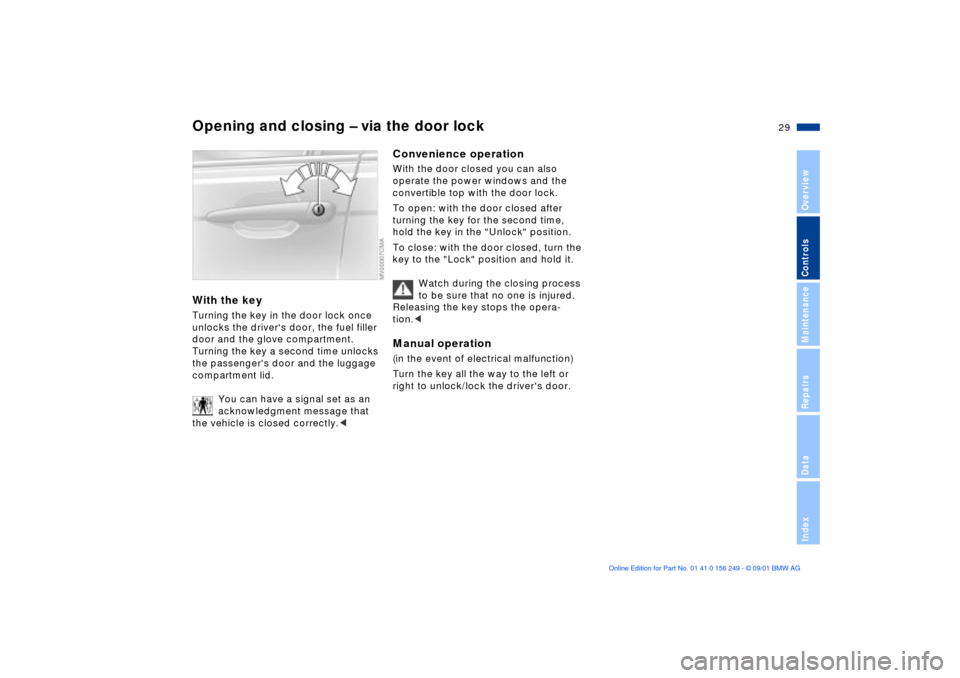
29n
OverviewControlsMaintenanceRepairsDataIndex
Opening and closing Ð via the door lockWith the keyTurning the key in the door lock once
unlocks the driver's door, the fuel filler
door and the glove compartment.
Turning the key a second time unlocks
the passenger's door and the luggage
compartment lid.
You can have a signal set as an
acknowledgment message that
the vehicle is closed correctly.<
Convenience operationWith the door closed you can also
operate the power windows and the
convertible top with the door lock.
To open: with the door closed after
turning the key for the second time,
hold the key in the "Unlock" position.
To close: with the door closed, turn the
key to the "Lock" position and hold it.
Watch during the closing process
to be sure that no one is injured.
Releasing the key stops the opera-
tion.
right to unlock/lock the driver's door.